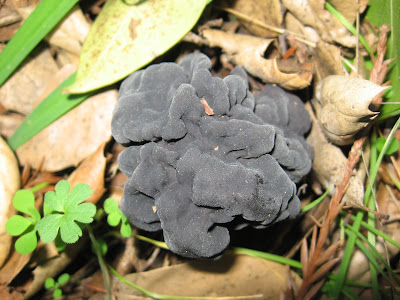
Although the winter garden has served us well, the plants aren't as large and sturdy as in previous years. Case in point: the rather spindly Bronze Arrow and Black Seeded Simpson lettuces pictured above. The vigorous volunteer Forget-me-not seedlings are taking over the bed.
The soil in all the beds is overworked, I think, because as soon as one crop comes out another goes in. I do add organic matter whenever possible but, clearly, it's not keeping up with the demand. What to do? Although there are now enough beds to let some go fallow and pile them with mulch for a season or two, I don't seem to be able to make time for that forward-looking task: the immediate gratification of planting and harvesting gets in the way.
Solution:
lasagna gardening. As I understand it, this approach involves building what amounts to a mini-compost pile of layered materials -- hence lasagna -- with soil on top like a very thick layer of Parmesan cheese. The claim is that the plants grow just fine even as the various layers are slowly breaking down and enriching the soil.
It's certainly worth a try. Maybe it's the perfect way to have our vegetables and eat them too -- to build soil and grow plants all in one smooth operation, just the way Mother Nature does it. And there is the immediate gratification of planting right away.

So today I ventured out to the yard to turn one of the garden beds into a yummy casserole of nutrients for the hungry roots of some lettuce seedlings from Cottage Gardens.
The hardest part -- which required violating my no-dig philosophy in order to get a quick fix to the problem of declining fertility -- was removing all the old, overworked soil. Once that was taken care of, after lots of little weeding breaks to rest my aging lumbar vertebrae, the rest was fun. All it took was layering in the best ingredients I could find to make up a real gourmet masterpiece.
The first layer was some hand-selected, carefully-aged sections of newspaper gently moistened with the hose. It was not too thick, just one or two sections worth of newsprint. The worms love this stuff, so I hope the newspaper will draw them to the area and get them interested in turning all the undigested organic matter into the top grade soil amendment only they can create.

The second layer was an inch or two of well-aged, locally-sourced manure from Pt. Reyes Compost, self-styled "purveyors of premium poop." The version I used is cheekily called "Double Doody," a mixture of cow and horse droppings, and the bag is marked by an image, half cow, half horse that reminds me of the two-headed Pushmi-pullyu creature from the Dr. Doolittle stories.

The third layer was thick pads of organic alfalfa hay, sprinkled with some high quality general purpose organic fertilizer (Whitney Farms Tomato & Vegetable Food, with a 4-5-3 balance of nitrogen, phosphate, and potash).

Next came a layer of leaves, also locally sourced (just down the block) and organically grown. This layer, too, was dusted with fertilizer. In fact, all the layers were, starting with the bare dirt before the newspapers were laid down.

The last layer was shovelfuls of the original dirt from the bed. There was room for more than half of it to fit back in, so there should be plenty of room for the lettuce to take hold, right on top of the gourmet lasagna layers. I soaked the whole assemblage thoroughly and let it mellow a bit.

It was nice to find a fair number of earthworms in the soil. I sure hope some red wiggler worms will show up to start digesting the layers of organic matter.

The last step was to set in the lettuce seedlings -- Forellenschluss and Garrison. Hope you like my casserole, little guys. Enjoy!















